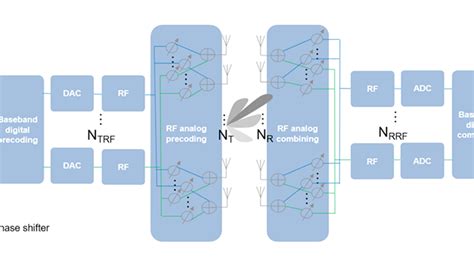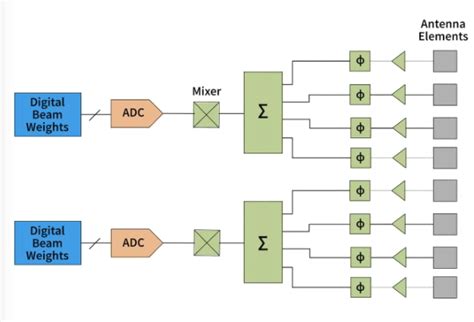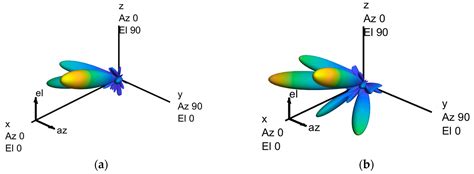Understanding Beamforming
Before delving into the specifics of hybrid beamforming, let’s first understand the concept of beamforming itself. Beamforming is a signal processing technique that enables the focusing of radio frequency (RF) energy in a specific direction. By adjusting the phase and amplitude of the signals transmitted or received by an array of antennas, beamforming allows for the creation of directional beams that can be steered towards the desired users or receivers.
Types of Beamforming
There are two main types of beamforming: analog beamforming and digital beamforming.
-
Analog Beamforming: In analog beamforming, the phase and amplitude adjustments are performed in the analog domain using phase shifters and variable gain amplifiers. This approach is simple and cost-effective but lacks the flexibility and precision of digital beamforming.
-
Digital Beamforming: Digital beamforming, on the other hand, involves processing the signals in the digital domain using complex algorithms. It offers higher flexibility, adaptability, and multi-user support compared to analog beamforming. However, digital beamforming requires a dedicated RF chain for each antenna element, which increases the hardware complexity and power consumption.
The Need for Hybrid Beamforming
As wireless communication systems evolve towards higher frequencies, such as millimeter-wave (mmWave) bands, the number of antenna elements required to achieve sufficient beamforming gain and coverage increases significantly. Implementing a fully digital beamforming architecture in such scenarios becomes impractical due to the high cost, power consumption, and complexity associated with having a large number of RF chains.
Hybrid beamforming addresses this challenge by combining the benefits of both analog and digital beamforming techniques. It aims to strike a balance between performance, complexity, and cost-effectiveness.

Architecture of Hybrid Beamforming
A typical hybrid beamforming architecture consists of two stages: an analog beamforming stage and a digital beamforming stage.
Analog Beamforming Stage
In the analog beamforming stage, a phase shifter network is employed to adjust the phase of the signals fed to each antenna element. This allows for the creation of a set of predefined analog beams that can be selected based on the channel conditions and user requirements. The number of analog beams is usually much smaller than the total number of antenna elements, reducing the complexity of the analog stage.
Digital Beamforming Stage
The digital beamforming stage follows the analog stage and operates on the reduced-dimensional signals. It performs additional signal processing, such as precoding, combining, and multi-user support. The digital stage provides the flexibility to adapt the beams dynamically based on the changing channel conditions and user demands.
The combination of analog and digital beamforming stages in a hybrid architecture enables the system to achieve high beamforming gain and directivity while keeping the number of RF chains and the overall complexity manageable.

Benefits of Hybrid Beamforming
Hybrid beamforming offers several advantages over traditional beamforming techniques:
-
Reduced Hardware Complexity: By employing a smaller number of RF chains compared to fully digital beamforming, hybrid beamforming significantly reduces the hardware complexity and cost of the system.
-
Enhanced Energy Efficiency: With fewer RF chains, hybrid beamforming consumes less power compared to fully digital beamforming, making it more energy-efficient.
-
Improved Spectral Efficiency: Hybrid beamforming enables the efficient utilization of the available spectrum by allowing multiple users to be served simultaneously through spatial multiplexing.
-
Increased Coverage: The high beamforming gain achieved by hybrid beamforming extends the coverage range of wireless networks, particularly in mmWave bands where signal attenuation is more severe.
-
Adaptability to Channel Conditions: The combination of analog and digital beamforming stages provides the flexibility to adapt the beams dynamically based on the changing channel conditions, ensuring optimal performance.

Challenges and Future Directions
Despite its numerous benefits, hybrid beamforming also presents several challenges that need to be addressed for its widespread adoption:
-
Channel Estimation: Accurate channel estimation is crucial for effective beamforming. However, estimating the channel in hybrid beamforming systems is more challenging due to the reduced number of RF chains and the presence of analog beamforming.
-
Beam Training and Tracking: Efficient beam training and tracking mechanisms are required to select the optimal analog and digital beams in real-time, especially in dynamic environments with mobility.
-
Complexity of Signal Processing: The digital beamforming stage in hybrid architectures involves complex signal processing algorithms, which may increase the computational complexity and latency.
-
Standardization and Interoperability: The development of standardized protocols and interfaces for hybrid beamforming is essential to ensure interoperability among different vendors and networks.
Ongoing research efforts are focused on addressing these challenges and further improving the performance of hybrid beamforming systems. Some promising future directions include:
- Advanced channel estimation techniques that leverage compressive sensing and machine learning algorithms.
- Efficient beam training and tracking schemes that minimize overhead and adapt quickly to changing environments.
- Low-complexity signal processing algorithms that reduce computational burden while maintaining performance.
- Integration of hybrid beamforming with other emerging technologies, such as massive MIMO and intelligent reflecting surfaces.
Frequently Asked Questions (FAQ)
-
What is the main advantage of hybrid beamforming over fully digital beamforming?
The main advantage of hybrid beamforming over fully digital beamforming is the reduced hardware complexity and power consumption. Hybrid beamforming requires fewer RF chains compared to fully digital beamforming, making it more cost-effective and energy-efficient. -
Can hybrid beamforming be used in sub-6 GHz frequency bands?
While hybrid beamforming is primarily targeted at mmWave frequencies, it can also be applied in sub-6 GHz bands. However, the benefits of hybrid beamforming are more pronounced in mmWave bands due to the higher number of antenna elements required and the increased path loss. -
How does hybrid beamforming impact the capacity of wireless networks?
Hybrid beamforming can significantly enhance the capacity of wireless networks by enabling spatial multiplexing and serving multiple users simultaneously. The high beamforming gain and directivity achieved by hybrid beamforming also improve the signal-to-noise ratio (SNR) and reduce interference, further increasing the network capacity. -
Is hybrid beamforming compatible with existing wireless standards?
Hybrid beamforming is being actively considered and incorporated into various wireless standards, including 5G NR (New Radio) and IEEE 802.11ad/ay (WiGig). Efforts are underway to ensure the compatibility and interoperability of hybrid beamforming with existing and future wireless technologies. -
What are the potential applications of hybrid beamforming beyond 5G?
Hybrid beamforming has applications beyond 5G wireless communication systems. It can be employed in various scenarios that require high-speed, low-latency, and reliable wireless connectivity, such as: - Wireless backhaul and fronthaul networks
- Satellite communication systems
- Radar and sensing applications
- Wireless virtual and augmented reality (VR/AR) systems
Conclusion
Hybrid beamforming represents a significant breakthrough in wireless communication technology, bridging the gap between the performance requirements of future networks and the practical constraints of hardware complexity and power consumption. By combining the strengths of analog and digital beamforming techniques, hybrid beamforming enables high-capacity, energy-efficient, and cost-effective wireless systems.
As research and development in hybrid beamforming continue to advance, it is expected to play a pivotal role in enabling the next generation of wireless networks, including 5G and beyond. With its ability to deliver high data rates, low latency, and massive connectivity, hybrid beamforming will unlock new possibilities in various application domains, from enhanced mobile broadband to mission-critical services and the Internet of Things (IoT).
However, realizing the full potential of hybrid beamforming requires ongoing efforts to address the associated challenges, such as channel estimation, beam training and tracking, and signal processing complexity. Collaboration among academia, industry, and standardization bodies is crucial to drive the development and adoption of hybrid beamforming solutions.
As we move towards a more connected and wireless future, hybrid beamforming will undoubtedly play a pivotal role in shaping the landscape of wireless communication systems, enabling seamless connectivity, immersive experiences, and unprecedented levels of performance.
Table: Comparison of Beamforming Techniques
| Beamforming Technique | Advantages | Disadvantages |
|---|---|---|
| Analog Beamforming | – Simple and cost-effective – Low power consumption |
– Limited flexibility – Lack of multi-user support |
| Digital Beamforming | – High flexibility and adaptability – Multi-user support |
– High hardware complexity – High power consumption |
| Hybrid Beamforming | – Reduced hardware complexity – Enhanced energy efficiency – Improved spectral efficiency – Increased coverage |
– Challenges in channel estimation and beam training/tracking – Complexity of signal processing |

No responses yet